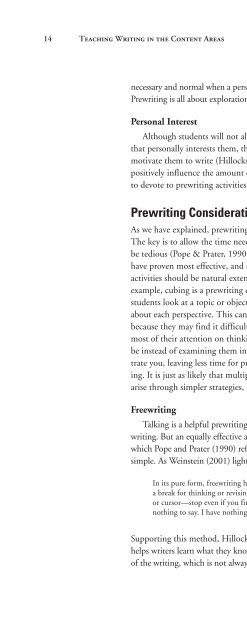How to Use It - ymerleksi - home
How to Use It - ymerleksi - home
How to Use It - ymerleksi - home
You also want an ePaper? Increase the reach of your titles
YUMPU automatically turns print PDFs into web optimized ePapers that Google loves.
14 Teaching Writing in the Content Areasnecessary and normal when a person is exploring horizons and possibilities” (p. 94).Prewriting is all about exploration and expanding the possibilities.Although students will not always have the opportunity <strong>to</strong> write about a <strong>to</strong>picthat personally interests them, the more you can encourage this, the more it willmotivate them <strong>to</strong> write (Hillocks, 1995; Friedman, 2000). This alone canpositively influence the amount of time and energy your students are willing<strong>to</strong> devote <strong>to</strong> prewriting activities.Prewriting Considerations and ActivitiesAs we have explained, prewriting is a necessary step, one not <strong>to</strong> be taken lightly.The key is <strong>to</strong> allow the time needed. To this end, prewriting activities should notbe tedious (Pope & Prater, 1990). Rather, some of the less structured methodshave proven most effective, and students are apt <strong>to</strong> like them. Moreover, theseactivities should be natural extensions of your content-area instruction. Forexample, cubing is a prewriting exercise, but it’s complicated. In this strategy,students look at a <strong>to</strong>pic or object from multiple perspectives and then writeabout each perspective. This can be a challenging exercise for your studentsbecause they may find it difficult <strong>to</strong> see beyond the obvious. They may focusmost of their attention on thinking about what the different perspectives couldbe instead of examining them in depth. This complicated strategy may also frustrateyou, leaving less time for prewriting strategies such as freewriting and talking.<strong>It</strong> is just as likely that multiple ways of viewing an object or concept willarise through simpler strategies, but in a natural rather than a contrived way.Talking is a helpful prewriting strategy—one that highlights the social nature ofwriting. But an equally effective activity that achieves the same goal is freewriting,which Pope and Prater (1990) refer <strong>to</strong> as “talking written down.” The process issimple. As Weinstein (2001) lightheartedly explains:In its pure form, freewriting has but one rule: Write continuously—taking ne’era break for thinking or revising—for ten whole minutes. Do not let that pen—or cursor—s<strong>to</strong>p even if you find yourself saying, “I have nothing <strong>to</strong> say. I havenothing <strong>to</strong> say. I have nothing <strong>to</strong> say.” (p. 61)Supporting this method, Hillocks (1995) reminds us that freewriting not onlyhelps writers learn what they know about a <strong>to</strong>pic, but it can also reveal the purposeof the writing, which is not always clearly defined when writers begin their work.
















